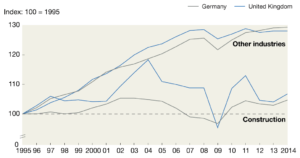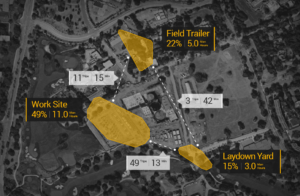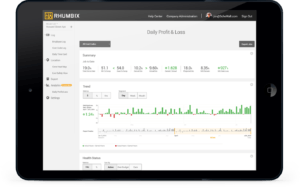Disrupting the Construction Industry Through the Use of Digitization

Construction has traditionally lagged behind other industries in terms of productivity rates because the variable nature of the work limits the standardization of tasks and the introduction of innovative technologies. However, the access to more reliable real-time data may change that in the near future.
Construction as an industry is vital for the progress of society. Not only does it account for 6% of global GDP (even 8% in emerging economies) but also it plays a key role in narrowing the infrastructure gap and enhancing economic development(1). Currently, the population of the world’s urban areas is increasing at a rate of 200,000 people per day and they all require access to affordable housing and essential public service infrastructure such as hospitals, schools, water and energy utilities and transportation(2). In fact, $57 trillion must be invested in infrastructure by 2030 just to keep up with economic growth(3).
Despite of the enormous challenges facing the industry, it has undergone little change in the last few decades; its productivity levels have remained stagnant and its profit margins low. For instance, overall labor productivity in Germany and the UK has increased by 30% since 1995 while labor productivity in the construction industry has increased only by 7% during that same period(4).
Exhibit 1 – Labor productivity (gross value added per hour worked) in Germany and UK.
There are several intrinsic challenges to the construction industry that restrain improvements in efficiency and profitability:
- The value chains are heavily fragmented,
- The transfer of knowledge between projects is limited because each project is unique,
- Projects are getting more complex; increasing number of megaprojects (>$1 billion)(5).
These challenges have limited the introduction of digitization and innovative technologies, which in turn have resulted in marginal productivity improvements as compared to those in other industries. Nonetheless, a San Francisco based startup (Rhumbix) has come up with a solution to one of the most relevant sources of inefficiency in the industry: labor management.
Labor costs in the construction industry account for a high percentage of the overall budget and yet they are extremely difficult to forecast and manage because they vary widely and the data available is generally inaccurate(6). Rhumbix is based around the need for accurate data in real-time. Data is captured through smartphones held by On-site workers. This data feeds a software platform that runs analytics and produces a series of interactive daily reports. Managers and engineers can use these reports to get insights on the workforce interaction patterns, site layout optimization and labor distribution(7).
Exhibit 2 – Sample of Rhumbix interface for site layout
Currently, on-site data collection is done by the foreman who manually fills in daily time cards with information about his crew and their specific daily activities. A lot of inaccuracy is introduced at this stage not only because of human error but also because work activities tend to change during the workday and don’t get recorded. Moreover, managers usually get the information one week later which limits their ability to influence performance because by the time they get last week’s information, the set of work activities carried out on-site have changed.
Rhumbix replaces the traditional paper-based time card with digital records that are fed by the GPS device in every worker’s smartphone. This increases the reliability of the information and the information is available to every engineer and manager in real-time. This gives way to infinite opportunities as managers can track the performance of each crew or worker, identify sources of productivity losses and immidiately take action to solve the problem.
Exhibit 3 – Sample of Rhumbix interface for worker location
Additionally, managers struggle to have a consolidated version of the on-site information on time. In consequence, they end up using historical ratios from past similar projects to forecast labor, equipment and materials needs. This practice results in huge differences between the budget and actual costs and, therefore, the project’s cash flow is impacted. Rhumbix provides managers with the actual production rates and uses them to forecast costs and completion dates, resulting in more precise forecasts.
Exhibit 4 – Sample of Rhumbix interface for daily profitability report
However, there is much room for improvement. First, it is an expensive solution because it requires that each worker is given a smartphone. The use of small GPS trackers could fulfill the same purpose at a fraction of the cost. Another improvement is that for now the solution is only applicable to the workforce. It could also be applied to equipment and inventory so that managers could have a holistic management tool for the construction site.
(Word Count 800)
[1] The World Economic Forum Industry Agenda, “Shaping the Future of Construction”, WEF, May 2016.
[2] The World Economic Forum Industry Agenda, “Shaping the Future of Construction”, WEF, May 2016.
[3] Blanco, Jose Luis, Mauricio Janauskas, and Maria Joao Ribeirinho, “Beating the low-productivity trap: How to transform construction operations”, McKinsey & Company, July 2016.
[4] Blanco, Jose Luis, Mauricio Janauskas, and Maria Joao Ribeirinho, “Beating the low-productivity trap: How to transform construction operations”, McKinsey & Company, July 2016.
[5] Blanco, Jose Luis, Mauricio Janauskas, and Maria Joao Ribeirinho, “Beating the low-productivity trap: How to transform construction operations”, McKinsey & Company, July 2016.
[6] Said, Carolyn, “Rhumbix uses data, app to boost efficiency at construction sites”, San Francisco Chronicle, November 10, 2015.
[7] “Continuously Improve Project Performance”, Rhumbix official site, https://www.rhumbix.com/solution/, Accesed November 2016.







Great post SAG! It is fascinating that the construction industry has had challenges with labor productivity given the immense need that has arisen out of the growth in the “megaprojects” segment . How much of this challenge do you view as a cultural one? In some ways the organization challenges of a manufacturing environment resemble those of a construction site with multiple skilled parties working on various parts of an end-product, but the productivity of manufacturing has far outpaced that of construction (170% in the past 10ish years, http://www.mckinsey.com/industries/capital-projects-and-infrastructure/our-insights/the-construction-productivity-imperative). Perhaps the difference is in the investment and education that has gone into the manufacturing ecosystem with tools such as Six Sigma/Lean and professions such as Industrial/Manufacturing engineering. Here is an interesting article that talks about the need to build and retain a skilled workforce in the construction industry: http://nccercornerstone.org/features/item/172-it-s-time-for-a-culture-change-in-the-construction-industry. It may be the case that having a skilled workforce might help with the organization and execution on worksites. Either way, I think this challenge is a significant one and definitely one that technology can help with.
I have often marveled at the logistical nightmare that is commercial construction, and am surprised to see that technology has yet to be fully utilized. I think you have highlighted a key inefficiency in our daily lives that goes under the radar because the workforce associated with it is so specialized. I also wonder if the project management structure (being largely contract-driven) has led to some stalled adaptation of technology. While I can certainly see the value in a tool like Rhumbix, I think tools like this would function optimally when all parties involved (suppliers, all workers, contractors, management companies, etc) were connected via the same interface. However, because they are all separately managed and working with different budgets, I can see this being an issue.
Great post SAG.
Ex. 1 is interesting – I know the productivity ratio is supposed to be agnostic to macro economic conditions but you can see a very clear “dip” in all of the lines during the 2008-09 financial crisis as well as a general stagnation across all industries after that period relative to improvements beforehand. I wonder if this indicates a broader trend of slowing productivity improvement due to a lack of reinvestment in the traditional business (buildings, R&D, etc.) in favor of financial engineering (share buy-backs, increasing dividends, etc.)? If that were the case, I would think construction productivity stagnation would have been a leading indicator as the industry felt the impact of businesses ceasing investment in new projects.
Very Informative post SAG!
Great description of the Construction industry disruption through digitization. We at Geniebelt have also explicated the topic in out blog post. Feel free to check it out and leave some feedback. https://geniebelt.com/blog/construction-expert-roundup